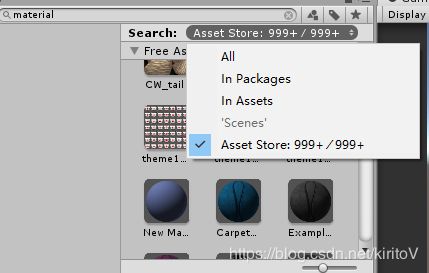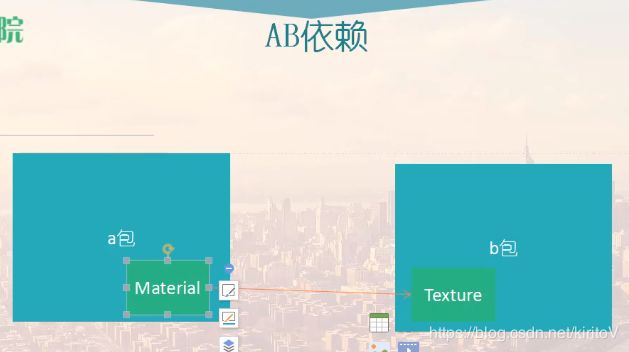【Lua热更新1】AssetBundle
目录
- 写在前面
- 什么是AssetBundle
- AssetBundle使用流程(简称AB)
- 将资源打包为AssetBundle
- AssetBundle的加载和使用
- 1.从内存加载
- 2.从本地加载
- 3.从服务器加载
- WWW.LoadFromCaheOrDownload
- UnityWebRequset
- AssetBundle分组策略总结
- 资源依赖关系
- 通过Manifest文件得到某个包的依赖
- AssetBundle的卸载
- 文件校验
写在前面
本文参考b站教程《AssetBundles Unity 热更新》
什么是AssetBundle
1.它是一个存在于硬盘上的文件,可以称之为压缩包(也可以认为是一个文件夹),里面包含了多个文件,分为两类:serialized file(序列化文件) 和resource files(源文件):
- serialized file:资源被打碎放在一个对象中,最后统一被写进一个单独的文件(只有一个),像一些Prefabs,模型等实例化才能看到的object
- resource files:某些二进制资源(图片、声音)被单独保存,方便快速加载
2.它是一个AssetBundle对象,可以通过代码从一个特定的压缩包把对象加载出来,这个对象包含了所有我们当初添加到这个压缩包里面的内容,我们可以通过这个对象加载出来使用。
AssetBundle使用流程(简称AB)
- 指定资源的AssetBundle属性(xxa/xxx- > xxa会生成目录xxx)
- 构建AssetBundle包
- 上传AB包
- 加载AB包和包里面的资源
trick:在Unity里搜索的时候选择“Asset Store”可以搜索免费的资源

将资源打包为AssetBundle
给编辑器加个菜单,通过[MenuItem(“AXX/BXX”)]就可以在编辑器的上边菜单栏增加一个下拉菜单AXX
- 创建脚本“CreateAssetBundles”
- 打包的时候不需要指定哪些资源,因为有标签的都会被打包
BuildAssetBundleOptions函数:
- BuildAssetBundleOptions.None:使用LZMA算法压缩。压缩的包更小,但是加载的时间更长,使用之前需要整体解压。一旦被解压,这个包会使用LZ4重新压缩,之后使用资源的时候不需要要整体解压。在下载的时候可以使用LZMA算法,一旦它被下载了之后,它会使用LZ4算法保存到本地上。
- BuildAssetBundleOptions.UncompressedAssetBundle:不压缩,包大,加载快。
- BuildAssetBundleOptions.ChunkBasedCompression:使用LZ4压缩,压缩率没有LZMA高,但是我们可以加载指定资源而不用解压全部。
注意使用LZ4压缩,可以获得可以跟不压缩相媲美的加载速度,而且比不压缩文件要小。
using System.Collections;
using System.Collections.Generic;
using UnityEngine;
using UnityEditor; //添加UnityEditor命名空间
using System.IO;
public class CreatAssetBundles //编辑器拓展不需要继承
{
[MenuItem("Assets/Build AssetBundles")] //将方法的运行放到菜单里面
static void BuildAllAssetBundles()
{
string dir = "AssetBundles";
if (Directory.Exists(dir) == false) //判断路径是否存在
{
Directory.CreateDirectory(dir);
}
//因为是在Unity里运行的,所有相对路径以根目录为准,打包后的文件放在“AssetBundles”目录下
//(输出目录,不设置,Build的AB包要使用的平台)
BuildPipeline.BuildAssetBundles(dir, BuildAssetBundleOptions.None, BuildTarget.StandaloneWindows64);
}
}
AssetBundle的加载和使用
在场景中创建一个GameObject,挂载脚本"LoadFromFileExample"
1.从内存加载
异步加载
using System.Collections;
using System.Collections.Generic;
using UnityEngine;
using System.IO; //添加命名空间
public class LoadFromFileExample : MonoBehaviour
{
// Start is called before the first frame update
IEnumerator Start() //使用协程
{
string path = "AssetBundles/scenes/wall";
//第一种加载AB的方式:从内存里加载
//异步方式,需要等待加载完成,返回值是一个AssetBundleCreateRequest
AssetBundleCreateRequest request = AssetBundle.LoadFromMemoryAsync(File.ReadAllBytes(path));
yield return request;
AssetBundle ab = request.assetBundle;
GameObject wallPrefab = ab.LoadAsset<GameObject>("wall"); //取得资源
Instantiate(wallPrefab); //把资源实例化到场景
}
}
同步加载
void Start()
{
string path = "AssetBundles/scenes/wall";
//同步的方式,会等待加载完才返回
AssetBundle ab = AssetBundle.LoadFromMemory(File.ReadAllBytes(path));
GameObject wallPrefab = ab.LoadAsset<GameObject>("wall"); //取得资源
Instantiate(wallPrefab); //把资源实例化到场景
}
2.从本地加载
异步加载
IEnumerator Start()
{
string path = "AssetBundles/scenes/wall";
//第二种加载AB的方式:LoadFromFile
AssetBundleCreateRequest request = AssetBundle.LoadFromFileAsync(path);
yield return request;
AssetBundle ab = request.assetBundle;
GameObject wallPrefab = ab.LoadAsset<GameObject>("wall"); //取得资源
Instantiate(wallPrefab); //把资源实例化到场景
}
同步加载
void Start()
{
//AssetBundle有两种类型,一种是文件夹,一种是对象
AssetBundle ab = AssetBundle.LoadFromFile("AssetBundles/scenes/wall"); //加载AssetBundles
GameObject wallPrefab = ab.LoadAsset<GameObject>("wall"); //取得资源
Instantiate(wallPrefab); //把资源实例化到场景
//加载AssetBundles里的所有资源,返回一个数组
//Object[] objs = ab.LoadAllAssets();
//foreach (Object o in objs)
//{
// print(o.name);
//}
}
3.从服务器加载
可以从服务器也可以从本地下载。如果已经下载完,就去cache(缓存)里面加载;没有的话就去www服务器上下载
从服务器上加载前,需要搭建搭建server服务器。 使用软件“NetBox”,会把当前目录作为服务器端的网站目录,打开默认是访问本机的IP地址,接下来要创建服务器的首页,创建文件“Index.html”。这样就相当于搭建了个远程服务器,只是搭建到了我们的电脑上。 之后将AssetBundle的文件夹与它们放在一起。
WWW.LoadFromCaheOrDownload
IEnumerator Start()
{
string path = "AssetBundles/scenes/wall";
//第三种加载AB的方式 www
while (Caching.ready ==false) //判断是否已经准备好使用这个方法
{
yield return null; //暂停一帧
}
//WWW.LoadFromCacheOrDownload(路径,版本号)
//本地的话,要加上@"file: + (/或者\,数量不定)",要具体到文件名
WWW www = WWW.LoadFromCacheOrDownload(@"file:/H:\unity\Save\Lua Test\AssetBundles\scenes\wall", 1);
//远程服务器要,要加上@"http: + // "
//WWW www = WWW.LoadFromCacheOrDownload(@"http://localhost/AssetBundles\scenes\wall", 1);
//判断www.error是否为空字符串/空对象,为空就继续运行,不为空说明有错误
if (string.IsNullOrEmpty(www.error) == false)
{
Debug.Log(www.error);yield break; //结束这个协程
}
AssetBundle ab = www.assetBundle;
GameObject wallPrefab = ab.LoadAsset<GameObject>("wall"); //取得资源
Instantiate(wallPrefab); //把资源实例化到场景
}
UnityWebRequset
using System.Collections;
using System.Collections.Generic;
using UnityEngine;
using UnityEngine.Networking; //添加命名空间
public class LoadFromFileExample : MonoBehaviour
{
// Start is called before the first frame update
IEnumerator Start()
{
//第四种方法,使用UnityWebRequest
//string uri = @"file:///H:\unity\Save\Lua Test\AssetBundles\scenes\wall";
string uri = @"http://localhost/AssetBundles\scenes\wall";
UnityWebRequest request = UnityWebRequestAssetBundle.GetAssetBundle(uri);
yield return request.Send(); //开始从服务器端下载
//AssetBundle ab = DownloadHandlerAssetBundle.GetContent(request);
AssetBundle ab = (request.downloadHandler as DownloadHandlerAssetBundle).assetBundle;
GameObject wallPrefab = ab.LoadAsset<GameObject>("wall"); //取得资源
Instantiate(wallPrefab); //把资源实例化到场景
}
}
AssetBundle分组策略总结
- 逻辑实体分组
- 一个UI界面或者所有UI界面一个包(这个界面里面的贴图和布局信息一个包)
- 一个角色或者所有角色一个包(这个角色里面的模型和动画一个包)
- 所有的场景所共享的部分一个包(包括贴图和模型)
- 按照类型分组
所有声音资源、shader、模型、材质打成一个包
- 按照使用使用分组
把某一时间内使用的所有资源打成一个包。可以按照关卡分,一个关卡所需要的所有资源包括角色、贴图、声音等打成一个包,也可以按照场景分,一个场景所需要的资源一个包
总结
- 把经常更新的资源放在一个单独的包里面,跟不经常更新分离
- 把需要同时加载的资源放在一个包里面
- 把其他包共享的资源放在一个单独的包里面
- 如果对于一个同一个资源有两个版本,可以考虑通过后缀来区分(v1,v2,v3)
资源依赖关系

把其他包共享的资源放在一个单独的包里面——>当物体、材质放在不同的包里时,当加载场景中某个物体时,要先把它依赖的资源加载出来,比如下面我们就将材质放在“Share”包里,物体放在“wall”包里,直接加载便会丢失材质

这时候需要先加载依赖的包
AssetBundle ab2 = AssetBundle.LoadFromFile("AssetBundles/share"); //加载材质的包
AssetBundle ab = AssetBundle.LoadFromFile("AssetBundles/scenes/wall");
通过Manifest文件得到某个包的依赖
AssetBundle manifestAB = AssetBundle.LoadFromFile("AssetBundles/AssetBundles");
//加载manifestAB里的资源,也就是AssetBundleManifest
AssetBundleManifest manifest = manifestAB.LoadAsset<AssetBundleManifest>("AssetBundleManifest");
//获得manifest里面所有的包内容
//foreach (string name in manifest.GetAllAssetBundles())
//{
// Debug.Log(name);
//}
//返回某个包的依赖
string[] strs = manifest.GetAllDependencies("scenes/wall");
foreach (string name in strs)
{
Debug.Log(name);
AssetBundle.LoadFromFile("AssetBundles/" + name);
}
AssetBundle的卸载
卸载能够减少内存的使用,也有可能导致丢失
- AssetBundle.Unload(true):卸载所有资源,即使有资源被使用着(可以用在关卡/场景切换,或着资源没用被用的时候)
- AssetBundle.Unload(false):卸载所有没用被使用的资源
文件校验
CRC、MD5、SHA1三种算法都是对数据进行计算,来生成一个校验值,该校验值用来校验数据的完整性。
不同的是:
- 算法不同。CRC采用多项式除法,MD5和SHA1使用的是替换、轮转等方法;
- 校验值的长度不同。CRC检验位的长度跟其多项式有关系,一般为16位或32位;MD5是16个字节(128位);SHA1是20个字节(160位);
- 校验值的称呼不同。CRC一般叫做CRC值;MD5和SHA1一般叫做哈希值(Hash)或散列值
- 安全性不同。这里的安全性是指检错的能力,即数据的错误能通过检验位检测出来。CRC的安全性跟多项式有很大关系,相对于MD5和SHA1要弱很多;MD5的安全性很高;SHA1的安全性最高。
- 效率不同。CRC的计算效率很高;MD5和SHA1比较慢。
- 用途不同。CRC一般用作通信数据的校验;MD5和SHA1用于安全领域,比如文件校验、数字签名等。




